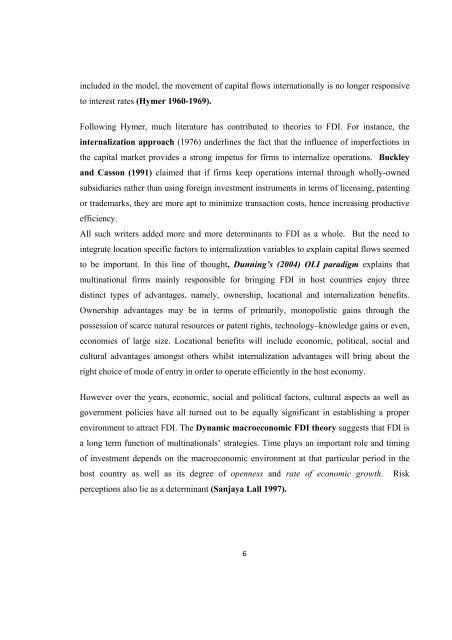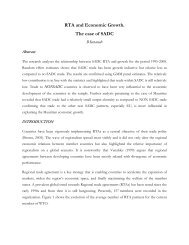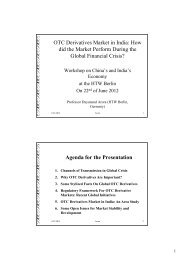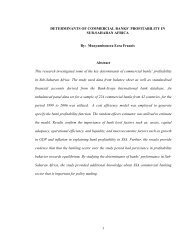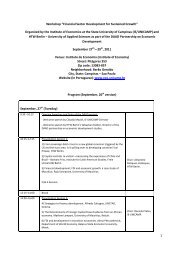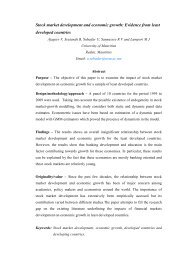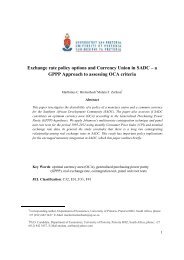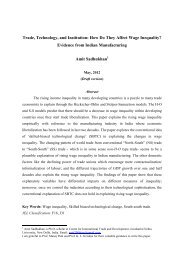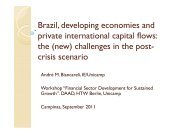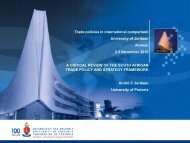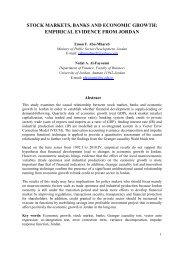On the Determinants of Foreign Capital Flows - DAAD partnership ...
On the Determinants of Foreign Capital Flows - DAAD partnership ...
On the Determinants of Foreign Capital Flows - DAAD partnership ...
Create successful ePaper yourself
Turn your PDF publications into a flip-book with our unique Google optimized e-Paper software.
included in <strong>the</strong> model, <strong>the</strong> movement <strong>of</strong> capital flows internationally is no longer responsive<br />
to interest rates (Hymer 1960-1969).<br />
Following Hymer, much literature has contributed to <strong>the</strong>ories to FDI. For instance, <strong>the</strong><br />
internalization approach (1976) underlines <strong>the</strong> fact that <strong>the</strong> influence <strong>of</strong> imperfections in<br />
<strong>the</strong> capital market provides a strong impetus for firms to internalize operations. Buckley<br />
and Casson (1991) claimed that if firms keep operations internal through wholly-owned<br />
subsidiaries ra<strong>the</strong>r than using foreign investment instruments in terms <strong>of</strong> licensing, patenting<br />
or trademarks, <strong>the</strong>y are more apt to minimize transaction costs, hence increasing productive<br />
efficiency.<br />
All such writers added more and more determinants to FDI as a whole. But <strong>the</strong> need to<br />
integrate location specific factors to internalization variables to explain capital flows seemed<br />
to be important. In this line <strong>of</strong> thought, Dunning’s (2004) OLI paradigm explains that<br />
multinational firms mainly responsible for bringing FDI in host countries enjoy three<br />
distinct types <strong>of</strong> advantages, namely, ownership, locational and internalization benefits.<br />
Ownership advantages may be in terms <strong>of</strong> primarily, monopolistic gains through <strong>the</strong><br />
possession <strong>of</strong> scarce natural resources or patent rights, technology–knowledge gains or even,<br />
economies <strong>of</strong> large size. Locational benefits will include economic, political, social and<br />
cultural advantages amongst o<strong>the</strong>rs whilst internalization advantages will bring about <strong>the</strong><br />
right choice <strong>of</strong> mode <strong>of</strong> entry in order to operate efficiently in <strong>the</strong> host economy.<br />
However over <strong>the</strong> years, economic, social and political factors, cultural aspects as well as<br />
government policies have all turned out to be equally significant in establishing a proper<br />
environment to attract FDI. The Dynamic macroeconomic FDI <strong>the</strong>ory suggests that FDI is<br />
a long term function <strong>of</strong> multinationals’ strategies. Time plays an important role and timing<br />
<strong>of</strong> investment depends on <strong>the</strong> macroeconomic environment at that particular period in <strong>the</strong><br />
host country as well as its degree <strong>of</strong> openness and rate <strong>of</strong> economic growth. Risk<br />
perceptions also lie as a determinant (Sanjaya Lall 1997).<br />
6


